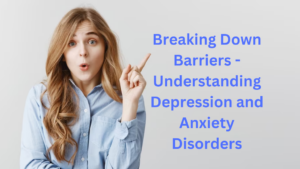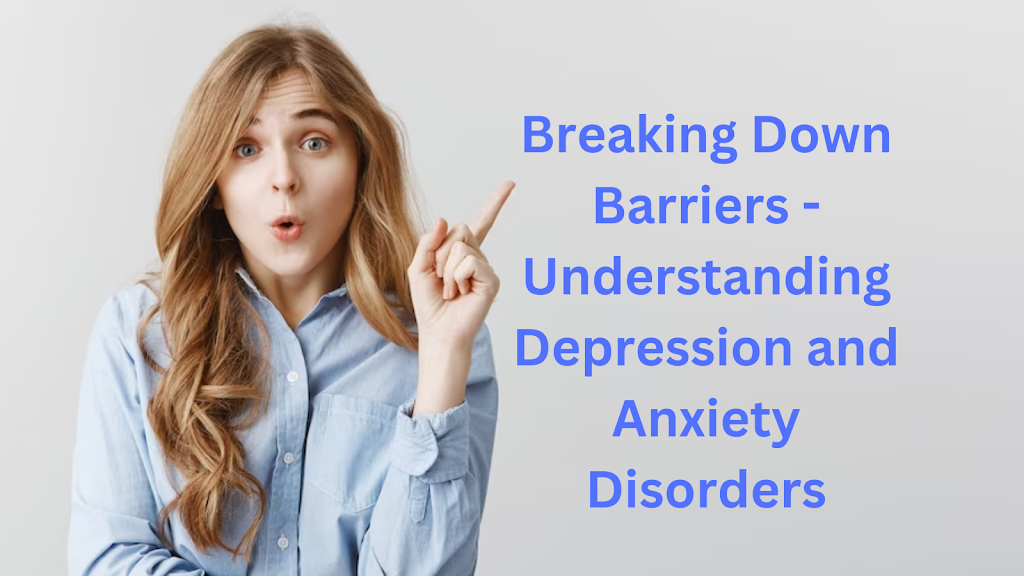Breaking Down Barriers – Understanding Depression and Anxiety Disorders
It’s no secret that mental health has been a huge issue for many people around the world. Whether it’s anxiety, depression, or any other mental health condition, it can be challenging to understand and cope with. But understanding is the key to breaking down the barriers of stigma and discrimination surrounding mental health conditions.
In this article, we’ll explore the different types of depression and anxiety disorders and how to recognize them. We’ll also look at the impact of these conditions on individuals and society as a whole. Most importantly, we’ll discuss how to seek help if you’re struggling with these types of mental health issues.
Living with a depression or an anxiety disorder can be overwhelming and sometimes even discouraging, but there is light at the end of the tunnel. No matter how scared you are to face your fears, there are strategies and support services available to help you cope. Let’s take a deep dive into understanding depression and anxiety disorders in order to start breaking down those barriers once and for all.
What Are Depression and Anxiety Disorders?
Depression and anxiety are two of the most common mental health issues in the world. But, unfortunately, many people don’t know exactly what they are or how to recognize their signs.
Depression is typically described as a feeling of deep sadness and hopelessness that can affect all areas of our life, from our work performance to our interpersonal relationships. It can last for weeks or months at a time, making an individual feel overwhelmed and unable to function normally. Anxiety disorders, on the other hand, involve excessive worry and fear that can interfere with daily activities and relationships. They can range from panic attacks to more persistent patterns of stress that disrupt day-to-day life.
 |
| Breaking Down Barriers – Understanding Depression and Anxiety Disorders |
Both depression and anxiety can be caused by a variety of physical and psychological factors—including genetics, environment, medical conditions and life events—and often coexist with other mental health issues like substance abuse or eating disorders. That’s why it’s important to talk to a trained professional if you’re experiencing any symptoms so they can identify the underlying cause and provide appropriate treatment options. Knowing how to recognize the signs of depression and anxiety is an important step in understanding these serious mental health issues.
Symptoms of Depression and Anxiety Disorders
Depression and anxiety disorders can present in many ways and the symptoms can vary in severity. You might feel overwhelmed and tired all the time, be irritable or angry, experience racing thoughts or trouble sleeping—it’s different for everyone.
These conditions can also have physical effects, from muscle tension to digestive issues. It’s important to know that there is no one-size-fits-all for depression and anxiety—everyone experiences them differently.
To make matters more tricky, symptoms of depression and anxiety disorders often overlap, so it’s not always easy to tell the difference between them. Some common signs include:
-
Persistent feelings of sadness or emptiness
-
Irritability or agitation
-
Loss of interest in activities once enjoyed
-
Difficulty concentrating
-
Relationship issues
-
Constant worrying
-
Panic attacks
-
Physical pain or discomfort
If you are experiencing any of these symptoms or are concerned about your mental health, talk to your doctor right away.
Causes of Depression and Anxiety Disorders
No single cause of depression and anxiety disorders exists; however, some factors can increase your risk. These include:
-
Biochemical
It’s possible that depression and anxiety disorders are caused by various biochemical factors that influence how we think, feel and act. These include imbalances in hormones, especially serotonin and dopamine, as well as disturbances in the body’s natural rhythms.
-
Genetic
Research suggests that certain people may have an inherited vulnerability to depression and anxiety disorders, meaning it runs in the family. However, this doesn’t necessarily mean that you’ll get it too—you may just be more susceptible to environmental or other factors which can trigger these mental health issues.
-
Environmental
The environment around us can also play a role in causing depression and anxiety disorders. This includes things like traumatic life events such as abuse or major life losses, stress brought on by financial problems or job-related issues, social factors like loneliness or isolation, or even something as simple as a physically unhealthy environment such as poor nutrition or lack of sleep.
By understanding what causes depression and anxiety disorders, you can better protect yourself from developing them in the first place—and if you already have them, you can make informed decisions about what kind of treatment is best for you.
Treatment of Depression and Anxiety Disorders
Treatment for depression and anxiety disorders is usually a combination of psychotherapy and medication. Knowing the right combination of treatments and therapies can go a long way in helping you manage your symptoms, so it’s important to get help from a mental health professional.
When it comes to psychotherapy, there are several different types that can be used in the treatment of depression and anxiety:
-
Cognitive Behavioral Therapy (CBT): This type of therapy helps you identify and change any unhelpful or negative patterns of thought that lead to depression and anxiety.
-
Dialectical Behavior Therapy (DBT): This type of therapy focuses on improving emotional regulation, interpersonal effectiveness, and distress tolerance.
-
Interpersonal Therapy (IPT): IPT helps individuals explore their relationships with others as a way to improve symptoms associated with depression and anxiety.
-
Mindfulness: This type of therapy helps individuals cultivate awareness, acceptance, and appreciation of their thoughts and feelings.
-
Exposure Therapy: This type of therapy encourages individuals to confront their fears in order to learn how to manage them better.
Medication can also be used as part of treatment for both depression and anxiety disorders. Depending on the severity of your symptoms, your doctor may prescribe medication such as antidepressants or anti-anxiety medications. As with any medication, it’s important to talk with your doctor about possible side effects before starting any new medication regimen.
Conclusion
Understanding depression and anxiety disorders requires a shift in the way we view mental health, and an understanding that mental illness is an illness like any other. It’s important to recognize that mental health issues are complex, and that there is no ‘one-size-fits-all’ approach to treatment.
Everyone is different and requires an individualized approach to recovery. However, it’s important to remember that recovery is possible, even for the most severe and chronic cases. Research has shown that the road to recovery is a long one, but with the right treatment and support, it is possible to break down the barriers of depression and anxiety and to lead a life worth living.
